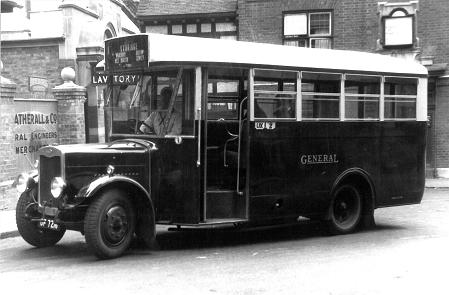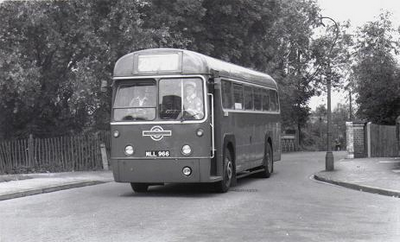|
|
 Central Area OMO before the RF Central Area OMO before the RF
Uxbridge routes 505 and 506
(later to become the 223 and 224 respectively) were the first
one-man routes operated by 'the Combine', as the Underground Group
including LGOC was known. Introduced in June 1930 to replace
Ks and Ss, the buses used were new Dennis Darts with Chiswick-built
18-seat bodies. Here, DA6 is seen at Uxbridge (presumably the
New Inn terminus, can anyone confirm?) in 1930.
Photo © N Hamshere
It is well known that the RFs were not
the first Central Area one-man operated buses. What seems
less well known is that OMO operations continued throughout the
second world war and did not finally cease until 1949.
For the London General Omnibus Company, the story starts
surprisingly late, in mid-1930 (it is possible that small
operators had adopted one-man operation earlier, but records seem
to be lacking. Can anyone help?). The seating capacity for
one-man operation was limited by law, so special small buses were
required and the first were Dennis Darts, the DA class (for more,
see Ian Smith's
site). Earlier single-deckers were of the B, K and S
classes, with traditional rear-entrance layout. Initial
introduction of the Darts enabled improved economics
of lightly used routes, and then the lower-cost introduction
of new routes. The Darts, together with similar buses
acquired from independent operators, were joined in 1936 by the
C-class Leyland Cubs.
The following routes were one-man
operated at the outbreak of the war.
|
205
|
Chingford Royal Forest Hotel
to Potters Bar Garage
|
|
205A
|
Waltham Cross to Hammond Street
Rising Sun
|
|
206
|
Esher Windsor Arms to
Claygate The Causeway
|
|
207
|
Barnes Railway Hotel to
Richmond Park Golf Course
|
|
216
|
Kingston Bus Station to
Staines Bridge Street
|
|
221
|
Pinner Red Lion to North
Harrow Station
|
|
223
|
West Drayton Station to Ruislip
Station
|
|
224
|
Stanwell to Staines Bridge
Street (daily), to Uxbridge New Inn (Mon-Sat)
|
|
237
|
Hounslow Garage to Chertsey
Station
|
|
252
|
Romford Birch Rd to Noak Hill
Pentowan
|
|
252A
|
Romford Birch Rd to Elm Park
Avenue The Broadway
|
As part of the campaign to reduce the
use of petrol, the last remaining Dennis Dart allocations (30 buses
on the 205, 206, 216, 223, 224 and 237) were converted to Cubs
shortly after the start of the war. Also in late 1939, the
need to reduce mileage led to the (permanent) withdrawal of the
207. The remaining routes were now operated by 20-seat
Cubs.
As part of the continuing campaign
during the war to increase bus capacity, many small-bus routes were
either double-decked (the 252A, as an extension of the
123, in December 1939) or otherwise upgraded to T or LTL
operation. The 205/A were converted in 1940, the
216 in 1941 (part) and 1942 and the 221, 223, 224 and 237 in
1942. Later in 1942, the 224 reverted to OMO, lasting until
1945, but Uxbridge to Harmondsworth shorts retained crew T
operation.
Two new OMO routes were introduced
during the war, the 238 (Emerson Park to Noak Hill) in 1940 and the
225 (Northwood Hills to Eastcote) in 1944, although the American
services traffic on the latter meant it was upgraded to crew buses
within five months.
By the end of the war, this left the
206, extended during the war to run Claygate to Imber Court, the
238 and the 252. The 206 was the first to go; OMO operation
ceased on 10 Sep 46 when the route was converted to 14T12 crew
operation and extended from Imber Court to Hampton Court
Station.
Many withdrawn Cubs were
retained. They operated (with conductors) as relief vehicles
on overloaded routes, and also operated shuttle services to and
from Wembley for Olympic Games participants in 1948, including (as
it happens) into Richmond Park where some of the athletes were
accommodated in the buildings of a WWII encampment near Ladderstile
Gate.
 Hornchurch ran the last 5 Cubs on the 238 and 252,
being finally withdrawn on 19 Jul 49 on conversion of the routes to
crew T operation, bring Central Area OMO to an end. The 252
had also hosted the first (petrol-engined) Cub, C1, in 1935.
In the Country Area, of course, Cub operation lasted until the
advent of the GS, meaning that Country OMO operation had an
unbroken run. But in the Central Area, it was to be another
15 years before OMO returned, in November 1964 on the 201 (NB), 206 (again)
(FW), 216 (again) (K) and 250 (NS). Hornchurch ran the last 5 Cubs on the 238 and 252,
being finally withdrawn on 19 Jul 49 on conversion of the routes to
crew T operation, bring Central Area OMO to an end. The 252
had also hosted the first (petrol-engined) Cub, C1, in 1935.
In the Country Area, of course, Cub operation lasted until the
advent of the GS, meaning that Country OMO operation had an
unbroken run. But in the Central Area, it was to be another
15 years before OMO returned, in November 1964 on the 201 (NB), 206 (again)
(FW), 216 (again) (K) and 250 (NS).
No Central Area OMO in
1953. In August 1953, RF329 was loaned from MH to NB on a
Bank Holiday for use on the 201
(an OMO route pre-war) and is seen carrying a blind from
a TD (sorry, the scan is poor) in what seems like deepest
countryside south of Hampton Court.
Photo © GA Rixon, Peter Gomm
collection
This note brings together details from various sources including
LOTS route data and Ken Glazier’s books; thanks are also due to
John
Hinson.
|
|